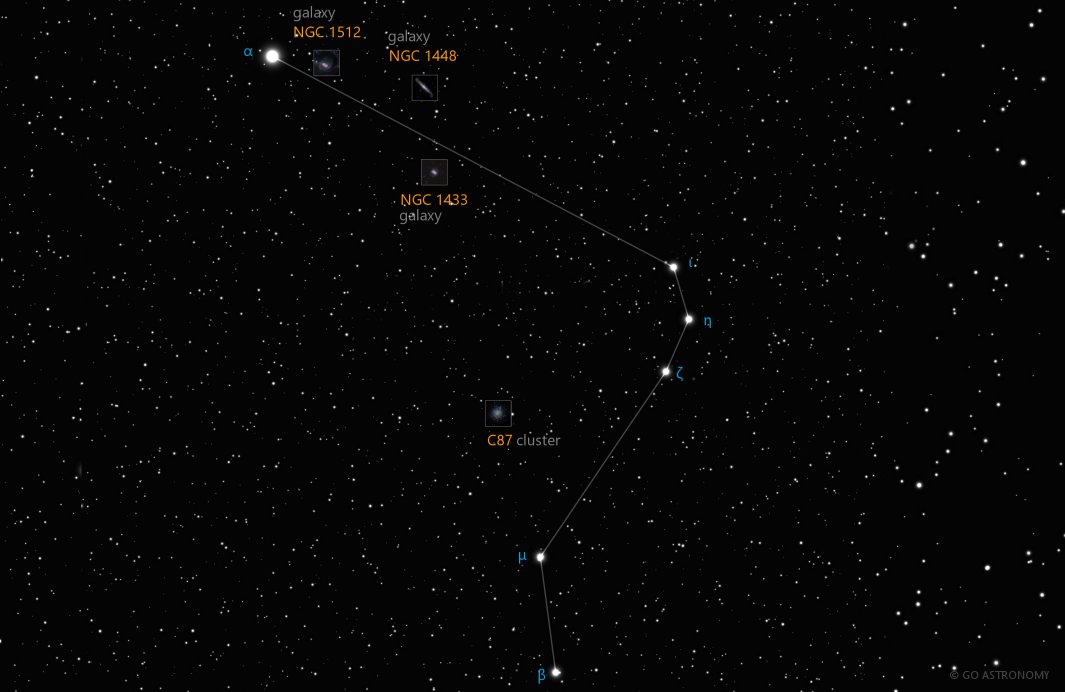Horologium, the Clock (Hor)
(hor-uh-LOW-jee-um)
The Southern constellation of Horologium, the Clock, is best viewed in Winter during the month of December.
Horologium is the 58th largest constellation. It's brightest star is Alpha Horologii at magnitude 3.85. The boundary of the Horologium constellation contains 3 stars that host known exoplanets.
- Pronunciation:
- hor-uh-LOW-jee-um
- Meaning:
- Clock
- Genitive:
- Horlogii
- Abbreviation:
- Hor
- Constellation Family:
- LaCaille
- Hemisphere:
- Southern
- Quadrant:
- SQ1
- Visibility:
- 30° N - 90° S
- Best viewing month*:
- December
- Area:
- 249 sq. degrees
- Size:
- 58th largest
- Right Ascension (avg):
- 3h 13m
- Declination (avg):
- -53°
- Brightest star:
- Alpha Horologii (3.85)
- Stars with planets:
- 3
- Messier objects:
- |
Brightest Stars in Horologium
The 10 brightest stars in the constellation Horologium by magnitude.
- Star
- Magnitude
- Spectral class
- Alpha Horologii (α Hor)
- 3.85
- K1III
- R Horologii (R Hor)
- 4.7
- M7IIIe
- Delta Horologii (δ Hor)
- 4.93
- A9V
- Beta Horologii (β Hor)
- 4.98
- A5III
- Mu Horologii (μ Hor)
- 5.12
- F0IV
- Zeta Horologii (ζ Hor)
- 5.21
- F4IV
- Nu Horologii (ν Hor)
- 5.25
- A2V
- Eta Horologii (η Hor)
- 5.3
- A6V
- HD 27588
- 5.33
- K2III
- Lambda Horologii (λ Hor)
- 5.36
- F2III
Star Clusters in Horologium
The most notable and easy-to-find star clusters in the constellation Horologium . Also see all star clusters.
Galaxies in Horologium
The most notable galaxies in the constellation Horologium. Also see all galaxies.
Milky Way Satellites in Horologium
Dwarf satellite galaxies that orbit the Milky Way Galaxy located in the constellation Horologium. Also see all Milky Way satellite galaxies.
- Galaxy name
- Alt name
- Magnitude
- Horologium I
- Horologium II
The Clock Constellation
Horologium, a constellation situated in the Southern Hemisphere, is known for its faint stars and for being home to various deep-sky objects. Though it's relatively inconspicuous, Horologium holds a few intriguing attributes for astronomers and star gazers alike. The name "Horologium" is Latin for "clock," making it known as the Clock Constellation.
Historical Overview
Horologium is a modern constellation, created by French astronomer Nicolas Louis de Lacaille in the mid-18th century during his expedition to the Cape of Good Hope. He originally named it "Horologium Oscillatorium" in honor of the pendulum clock, a significant invention of his time. However, the name was later shortened to Horologium. Despite its relatively recent designation, Horologium lacks specific mythology connected to its formation.
Location and Main Features
Horologium is located in the first quadrant of the Southern Hemisphere (SQ1), and it can be viewed at latitudes between +30? and -90?. This constellation is bordered by five other constellations: Eridanus, Caelum, Reticulum, Dorado, and Hydrus. Its largest star, Alpha Horologii, is quite faint, making Horologium challenging to locate in the night sky without the aid of a star map or a computerized telescope.
Major Stars
The brightest star in the constellation, Alpha Horologii, is an orange giant star located about 115 light years from Earth. However, even as the brightest star in Horologium, it has an apparent magnitude of only 3.85, making it quite faint when viewed from Earth.
Other notable stars include Beta Horologii, a yellow-white F-type giant, and Delta Horologii, an orange K-type giant. Both stars are binary systems, each with an apparent magnitude of 4.98 and 4.93, respectively. However, their dimness makes them relatively challenging to observe without adequate equipment.
Deep Sky Objects
Despite its dim stars, Horologium is home to several interesting deep sky objects. The Horologium-Reticulum Supercluster of galaxies, located approximately 700 million light-years away, is one of the most massive galaxy clusters known. The constellation also contains the Horologium Dwarf, a dwarf galaxy that is part of the Local Group of galaxies, which also includes our Milky Way.
Other intriguing objects include NGC 1261, a globular cluster discovered in the 19th century, and the spiral galaxy NGC 1433. The latter is a Seyfert galaxy, a category of galaxies with extremely bright, active nuclei.
Observation
The best time to observe the stars and deep-sky objects of Horologium is during its culmination in the winter months. However, given the constellation's location and the faintness of its stars, it is best viewed from the southern hemisphere, or from low northern latitudes. A dark sky and a powerful telescope will assist observers in discerning the constellation's features and deep sky objects.
Horologium in Modern Astronomy
Horologium, while not particularly noteworthy for its stars, is valuable for its deep-sky objects, notably for the study of galaxies and globular clusters. It has also been an area of interest in the search for extrasolar planets. For instance, the star HD 27631, located in Horologium, has been found to have a planet orbiting it.
Despite its relatively obscure status and low brightness, Horologium carries a unique charm, representing a particular epoch's scientific advancement and hosting a variety of fascinating astronomical objects. It is a splendid example of the myriad wonders that await discovery in even the faintest corners of our night sky.
* Constellation shown for northen hemisphere skies. For the southern hemisphere, constellations appear rotated 180 degrees (upside-down and left-right reversed) from what is shown. Remember that seasons are reversed too - summer in northern latitudes is winter in southern latitudes.
** Circumpolar constellations are visible year-round in the hemisphere listed (and not at all in the opposite hemisphere).





